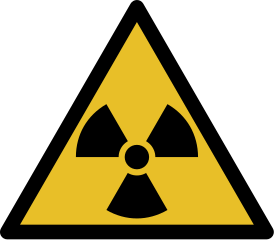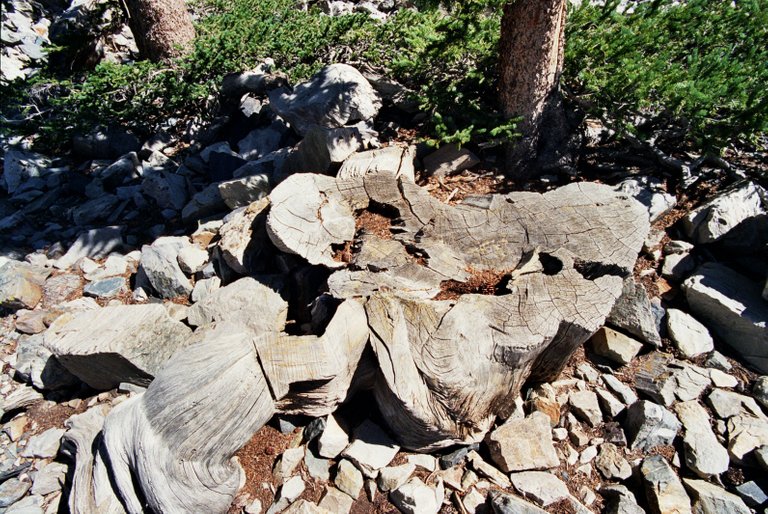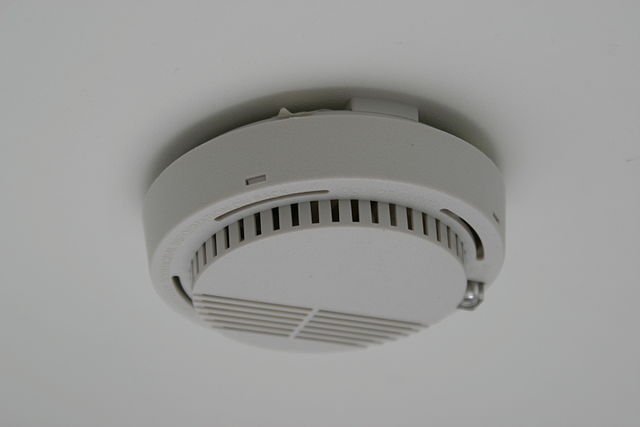ATOMIC NUCLEUS: Uses And Dangers Of Radioactivity
Greetings to all my readers and the entire STEM communities. I will like to conclude my series on the Atomic Nucleus and How Nuclei Change as a Result of Radioactive Decay, Mass Defect, and Binding Energy by explaining to us the Uses and Dangers of Radioactivity. One of these uses is found in the smoke detector.
THE SMOKE DETECTOR
Most radioactive sources used in industrial and other applications are artificial radioactive isotopes. They are made from stable elements by using the stream of neutrons from a nuclear reactor. Being uncharged, neutrons can penetrate the atomic nucleus quite easily.

When an ordinary stable nucleus gains extra neutrons, it becomes unstable with a probability of decaying by either negative or positive beta emission, as explained in my previous articles.
Most applications of radioactivity are in industry or medicine, but the most common is found in almost every home – the smoke detector. It uses a small amount of the nuclide americium-241 with a half-life of 433 years. There are tiny amounts of it in mineral ores of uranium, but commercially it is produced by irradiating plutonium with neutrons in a nuclear reactor.
As a nuclide with a comparatively massive nucleus, americium-241 decays by the alpha process. In the smoke detector, alpha particles in a steady stream collide with molecules in the air and ionize them. The ions move towards the electrodes, maintaining a small continuous current. Smoke particles from a fire are much bigger than air molecules and are more likely to intercept the alpha particles, absorbing them and so decreasing the ionization current. When the current drops, an alarm is triggered via an electronic amplification system.
THE DANGERS OF IONIZING RADIATIONS
Living cells contain complex molecules which are easily damaged by ionizing radiation. The key molecules likely to be damaged are DNA and RNA. They are involved in the production of proteins, which include the enzymes that control the synthesis of all the biochemicals needed for the growth and reproduction of cells.
Alpha radiation is heavily ionizing and can be most damaging to cells, so alpha emitters are dangerous if they enter the body. But alpha radiation is easily absorbed: its range in air is only a few centimetres and a sheet of paper is enough to act as a shield.
Beta particles are less ionizing but have a longer range. So they can penetrate deeper into the body from external sources. Anyone working with beta emitters must wear protective clothing.
Gamma radiation is the least ionizing but far more penetrating, so is considered the most dangerous.
MEASURING THE BIOLOGICAL EFFECT
The variety of radiations and their differing penetration and ionizing effects mean that simply measuring the activity of a source doesn’t tell us much about the effect the emissions may have on the body. What matters is a combination of the energy released in the body by the ionizing radiation and the relative ionizing effect on living tissue.
The energy absorbed in the tissue is measured as the dose, in units of Joules per kilogram, called the gray (Gy): 1 Gy = 1 Jkg-1
To allow for the different ionizing abilities of the radiation, we multiply the energy absorbed per kg in grays by a quality factor that depends on the radiation: for X-rays, gamma rays, and beta particles the factor is 1; for alpha particles, it is 20. The result is a quantity called the dose equivalent, and this is measured in sieverts (Sv).
The table below summarises the units related to radioactivity.
| Quantity | Unit | Definition |
|---|---|---|
| Activity | becquerel (Bq) | decay rate in decays per second |
| Dose | gray (Gy) | energy absorbed in tissue from radiation, in Jkg-1 |
| Dose equivalent | sievert (Sv) | a measure of likely tissue damage, calculated as: dosage × quality factor. |
Older units still in use:
Curie = 3.7 × 107 Bq, Rad = 0.001 Gy, Rem = 0.001 Sv
CARBON DATING
The carbon dioxide in the atmosphere is used by plants to build their main structures; roots, stems, trunks, branches, leaves and seeds. Atmospheric carbon is a mixture of the main isotope carbon-12 (98.89%), carbon-13 (1.11%): also tiny traces of carbon-14, which is radioactive with a half-life of 5730 years. It is being formed continuously as high-energy cosmic rays from space collide with atmospheric nuclei. They break up, producing neutrons and other fragments. The neutrons then enter nitrogen nuclei, which are disturbed enough to lose a proton and so form carbon-14. The process is:
147N + 10n → 146C + 11p
Carbon-14 eventually combines with oxygen to form carbon dioxide, CO2 Both 12CO2 and 14CO2 in the atmosphere are taken up by plants. Therefore, carbohydrates in all plants contain radioactive carbon in the same ratio as carbon-14 to carbon-12 in the atmosphere at any time. So do carbohydrates in animals and other organisms whose tissues contain carbon derived from plants.

When a plant dies, its store of carbon-14 stops being recycled, so that as radioactive decay occurs the proportion of carbon-14 decreases. Thus the ratio of carbon-14 to carbon-12 in a piece of wood, say, many hundreds of years old will give a measure of the time that has elapsed since that piece of wood died.
A modern piece of wood has an activity per kilogram (its specific activity) due to carbon-14 of 250 s-1. Say the specific activity of wood from an old building is 125 s-1 kg-1, then the wood must be one half-life old: 5730 years. More generally, if the zero-age specimen has a specific activity A0 and the specimen of age t has a specific activity A then A = A0 e-kt where k is the decay constant of carbon-14.
As an example, suppose A was measured to be 50 s-1 kg-1 then we can say:
50 = 250 × e-kt = 250/ekt
Ог: ek = 5
giving: kt = In 5 = 1.61
k × half-life = In 2
A half-life of 5730 years means a decay constant k of (In 2)/5730 per year, so the age of the specimen is:
T = 1.61/k = 5730 × 1.61/0.693
= 13 300 years
= 13 300 years
Carbon dating is not an exact method. The energy of the beta particles emitted is low and some would get absorbed inside the material, so small samples are vaporized to avoid this. But with such small samples, the error in counting these random events is significant, especially with older materials of low activity.
The method also assumes that cosmic ray activity has been constant over many thousands of years, though it has not. To correct for this, the radioactivity in the wood of tree rings of living trees (bristlecone pines in California) many thousands of years old has been used to calibrate radiocarbon dates much more accurately. Now, the accuracy of dating is about ±200 years in the range of 600 to 10,000 years. In 2001, an Anglo-American team studied – of all things – a 50 cm long stalagmite that grew in a Bahaman cave during the last major ice age about 20,000 years ago. It has been preserved by being underwater deep inside the cave system. Their investigations showed that the levels of carbon-14 fluctuated wildly during the time the stalagmite was growing. It suggests that we should add perhaps 8,000 years to currently accepted values for artifacts and fossils that are about 30 000 years old.

Carbon dating is the best-known dating technique. It has revolutionized the work of archaeologists, geologists, and paleontologists. At the same time, they are also using longer-lived radioactive nuclides to date materials over far greater time spans.
CONCLUSION
This series of posts on ATOMIC NUCLEUS has dealt with radioactivity and the nature and basic structure of the atomic nucleus. Having read the entire articles starting from ATOMIC NUCLEUS: Energy and Politics, Activity and Half-life, Forces in the Nucleus, How Nuclei Change #1, How Nuclei Change #2, How Nuclei Change #3, and this concluding post, I explained:
- The properties of the ionizing radiation emitted by radioactive sources, including range, ionizing ability and shielding.
- How the radiations are detected and monitored (Geiger counter, solid-state detector, etc.).
- The sources of radiation (including background radiation) and understand the concepts of activity and decay.
- That activity decreases exponentially, giving rise to a half-life for the decay of a particular active nuclide.
- How to estimate a half-life from a graph of activity.
- That the decay is random, based upon a probability of a decay occurring.
- The ability to use the mathematics of decay and the decay constant.
- How the atomic nucleus was discovered and some details of the Geiger-Marsden experiment.
- That the nucleus consists of two kinds of nucleon – protons (positive charge) and neutrons (uncharged).
- That the number of protons in the nucleus decides íts atomic number (proton number) Z and that the mass number (nucleon number) A is the sum of the numbers of protons and neutrons.
- That nuclei of the same element have the same number of protons but may have different numbers of neutrons (isotopes).
- That nucleons are held together in a nucleus by the strong nuclear force, whilst protons repel each other due to their electric charge.
- How the masses of nuclei may be measured.
- How a mass spectrograph works and that it provides the evidence for mas differences between nuclei,
- How the size of a nucleus is related to its nucleon number, and that all nuclei have much the same (very high) density.
- What happens in the nucleus when decay occurs and understand the concept of a radioactive decay series.
- That for a nucleus to be stable there must be a balance between the numbers of protons and neutrons.
- That forces in the nucleus give rise to negative potential energy (binding energy) which is observed as a loss in mass (mass defect).
- The significance of the plot of binding energy per nucleon (BEPN) against nucleon number Ar and use it to explain how nuclear fusion or fission may produce energy.
- Some theories about the cause of radioactive decay, for the alpha, beta minus and beta plus, and gamma processes, and the discovery of the neutrino.
- The nuclear fission, chain reaction and nuclear waste, and the simple workings of a nuclear reactor.
- The advantages and disadvantages of nuclear power.
- The uses and dangers of radioactive sources and their emissions.
Till next time, I remain my humble self, @emperorhassy.
Here is the link to my twitter profile: https://twitter.com/HasmondM/status/1256484544112402432?s=19
Thanks for coming.
REFERENCES
https://www.ck12.org/c/chemistry/effects-of-radiation/lesson/Dangers-and-Uses-of-Radiation-MS-PS/
https://www.bbc.co.uk/bitesize/guides/zp86v9q/revision/1
https://www.bbc.co.uk/bitesize/guides/z83dxfr/revision/3
https://sciencing.com/dangers-uses-radioactivity-5468526.html
https://www.ifsecglobal.com/smoke-detectors/
https://www.explainthatstuff.com/smokedetector.html
https://en.wikipedia.org/wiki/Smoke_detector
https://en.wikipedia.org/wiki/Ionizing_radiation
https://www.sciencedirect.com/topics/engineering/radiation-absorbed-dose
https://opentextbc.ca/chemistry/chapter/21-6-biological-effects-of-radiation/
http://hyperphysics.phy-astr.gsu.edu/hbase/Nuclear/cardat.html
https://www.britannica.com/science/carbon-14-dating
https://theconversation.com/explainer-what-is-radiocarbon-dating-and-how-does-it-work-9690

Thanks for your contribution to the STEMsocial community. Feel free to join us on discord to get to know the rest of us!
Please consider supporting our funding proposal, approving our witness (@stem.witness) or delegating to the @steemstem account (for some ROI).
Please consider using the STEMsocial app app and including @steemstem as a beneficiary to get a stronger support.